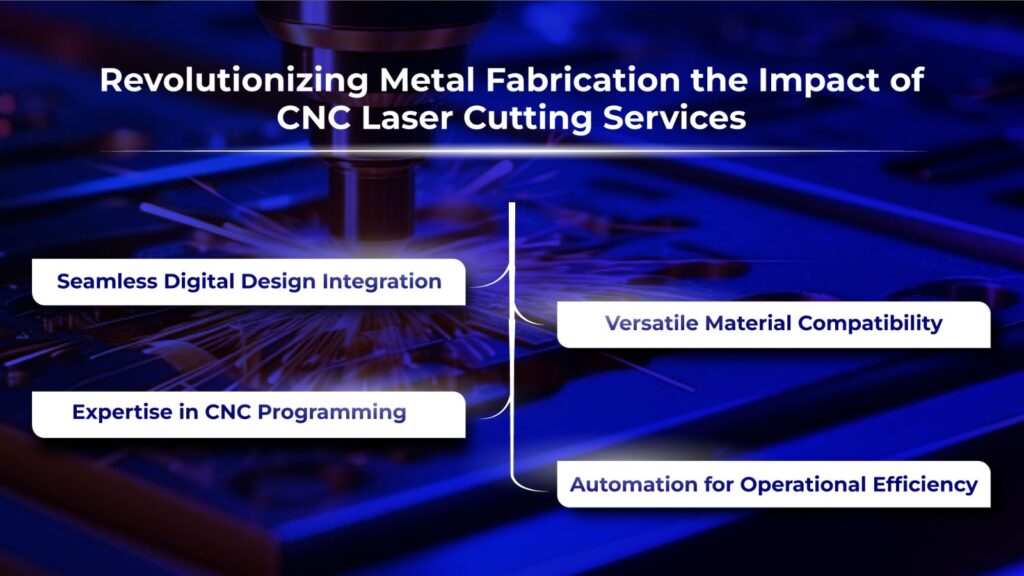Adoption of cutting-edge technologies has become a cornerstone for industries striving to meet evolving demands. Among these innovations, Computer Numerical Control (CNC) laser cutting services have emerged as a transformative force, redefining precision, efficiency, and versatility in metalworking. This blog delves into the industry-level advances brought about by CNC laser cutting services, addressing the What, How, and Why aspects of its impact on metal fabrication across diverse sectors.
What Drives the Shift Towards CNC Laser Cutting Services Across Industries?
Demand for Precision Components:
The increasing demand for precision-engineered components spans various industries, from automotive to electronics. Modern product designs require complicated cuts and complex geometries, which are typically difficult to achieve using traditional cutting methods. CNC laser cutting, renowned for its high precision and accuracy, emerges as a pivotal solution, catering to the demand for precisely crafted components in diverse sectors.
Customization Imperatives:
Customisation is not just a necessary but also a preference in the fast-paced industry of today. Industries use specialised components and unique designs to set their products apart from the competition. CNC laser cutting’s unparalleled versatility allows manufacturers to meet these customization needs efficiently. Whether it’s crafting tailored components for automotive applications or specialized parts for industrial machinery, CNC laser cutting accommodates the diverse customization requirements of various sectors.
How Does CNC Laser Cutting Services Elevate Metal Fabrication Processes in Different Industries?
1. Seamless Digital Design Integration:
CNC laser cutting services commence with the integration of digital design into the manufacturing process. Designers input precise specifications into Computer-Aided Design (CAD) software, creating a virtual model of the intended metal component. This digital design seamlessly translates into a CNC program, acting as a precise roadmap for the laser cutting machine to follow.
2. Expertise in CNC Programming:
The heart of CNC laser cutting lies in the complex CNC programming that guides the entire process. Skilled programmers develop a set of instructions that direct the CNC system to operate the laser beam across the metal sheet with precision. This ensures that the actual cut aligns perfectly with the intended design, fostering consistency and maintaining high-quality standards throughout the production process.
3. Versatile Material Compatibility:
CNC laser cutting is not restricted to specific types of metals; it accommodates various materials with equal efficiency. This versatility broadens the spectrum of applications across different industries, reducing the need for specialized equipment for distinct materials. This adaptability streamlines the manufacturing process, making CNC laser cutting an attractive choice for industries dealing with a diverse range of materials.
4. Automation for Operational Efficiency:
The efficiency of CNC laser cutting services is closely tied to its automation capabilities. The process is highly automated, minimizing human intervention and reducing the risk of errors. Quick setup times, rapid cutting speeds, and minimal downtime contribute to a seamless and efficient production workflow. Automation not only accelerates production timelines but also enhances overall operational efficiency.
Why is CNC Laser Cutting Considered a Game-Changer in Metal Fabrication Across Industries?
1. Unmatched Precision:
 The precision offered by CNC laser cutting services sets new industry benchmarks. Manufacturers can achieve cuts with tolerances as tight as a fraction of a mm, ensuring that the final product meets exact specifications. This precision is particularly crucial in industries where even slight deviations can impact the functionality and safety of the end product.
The precision offered by CNC laser cutting services sets new industry benchmarks. Manufacturers can achieve cuts with tolerances as tight as a fraction of a mm, ensuring that the final product meets exact specifications. This precision is particularly crucial in industries where even slight deviations can impact the functionality and safety of the end product.
2. Scalability and Production Speed:
The scalability of CNC laser cutting services is a game-changer for industries involved in large-scale production. The automated nature of the process allows for quick adaptation to varying production volumes. Whether it’s a small batch of highly specialized components or a large-scale production run, CNC laser cutting delivers consistent results without compromising speed or quality.
3. Cost-Effective Production:
While the initial investment in CNC laser cutting technology may be significant, the long-term cost benefits are substantial. The efficiency of the process reduces labour costs, minimizes material wastage, and enhances overall production throughput. The ability to produce more components in less time translates to cost-effective manufacturing, making CNC laser cutting a strategic investment for businesses looking to optimize their bottom line.
4. Versatility and Innovation:
CNC laser cutting’s versatility extends beyond traditional cutting methods, allowing manufacturers to explore innovative designs and create intricate patterns that were previously challenging to achieve. This not only enhances the aesthetic appeal of final products but also opens up new possibilities for product development and differentiation in competitive markets.
Conclusion:
The integration of CNC laser cutting services into the metal fabrication industry marks a significant advance with far-reaching implications. Accuracy, effectiveness, and adaptability are now attainable benchmarks in a variety of industries, including electronics and automotive. The demand for precision components, customization, and cost-effective production is continuing to rise, and CNC laser cutting is paving the way for new standards of innovation. Embracing this technology is not just a strategic move; it’s a decisive step towards staying competitive and future-proofing operations in the rapidly evolving world of metal fabrication across diverse industries.

